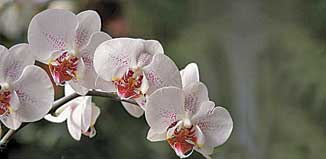
The key to successful orchid growing is to replicate their original habitat (the Himalayas, down to Malaysia to Australia) as closely as you can. However, orchids are tolerant plants — you can kill an orchid with kindness, but not with neglect. Remember that huge yellowy-green cymbidium Grandma grew in a big pot, stuck behind the garage, thriving on neglect but still managing to put up a couple of flower spikes every year.
Cymbidiums are one of the easiest of orchids to grow, generous and forgiving, bearing neglect yet still prepared to give a good flowering. An ideal position for these plants is under a tree (away from strong winds). This will provide dappled sunlight during the heat of the day — hot sun will burn leaves, but too little sun will reduce flowering. If your orchid has green, lush-looking leaves it means your plant is in too much shade for good flowering — leaves should be a light apple-green.
Flower spikes appear around May or June (mine are showing now) and should be protected from slugs and snails who love the emerging buds. Remove dead flower spikes as soon as blooms have finished.
Cymbidiums like frequent watering and feeding. As a general guide, use flowering orchid food from February through to end of flowering season (usually around October/November) and switch to growing orchid food until the end of January.
As well as the popular cymbidium, two other orchids will thrive with only moderate care.
The moth orchid (Phalaenopsis) originates from India, through South-east Asia, north to the Philippines and south to Northern Australia, so it’s no surprise they love a well-lit, warm position.
Grow these orchids indoors all year, out of direct sunlight and drafts and away from windows (the first place to get cold at night). Watering and feeding frequency depends on how warm and dry your house is, but every seven to ten days is sufficient. Mix a solution of orchid food to use as a one-step, combined water and feed. Keep leaves dry — just water around the base of your plant.
Australian dendrobiums (bush or rock orchid) come from various parts of Australia. The bush orchid can be found growing on trees in the eastern mountains behind Melbourne through to Sydney. It requires similar conditions to cymbidiums. The rock orchid grows on rocks on riverbanks in Queensland so will tolerate direct sunlight.
Like cymbidiums, you can have dendrobiums inside while they’re in flower to enjoy blooms andamazing perfume. After flowering (flower spikes should show about July or August) they too need to be returned outside.
Water and feed your plants regularly, using flowering or growing orchid food, depending on the time of year.
Repotting is the same as for cymbidiums — both like to be slightly pot-bound, but once bulbs have filled the pot and there appears to be no more room for growth, the plants need to be re-potted. Spring is a good time for repotting, but don’t break your clump up into lots of small pieces — the smaller the clump, the longer it takes to flower.

